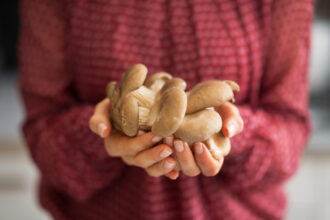When optimists are buried in proverbial lemons, they make lemonade. When the women who own Intentional Growth Farm in Utah had too many hemp stalks, they produced exceptionally large, tasty mushrooms.
“We used the hemp stalks as the nutrient source for our oyster mushrooms, and customers said they were the best mushrooms they ever tasted,” explained Natasha Quinones-Rodriquez, who manages crop production at Intentional Growth Farm, a small collection of greenhouses in Logan, Utah. “We suspect hemp stalks can increase specialty mushroom yield and nutrition while reducing production costs and providing a valuable use for industrial hemp waste.”
Quinones-Rodriquez recently received a $25,000 grant from Western Sustainable Agriculture Research and Education to compare the economical, nutritional and environmental benefits of cultivating mushrooms with hemp stalks rather than the more commonly used straw. Other farmers have used hemp stalks to feed mushrooms, but there is little data to support the practice.
“We will be working with scientists at Utah State University so we can help develop empirical evidence to share with other farmers,” said Quinones-Rodriquez, who runs Intentional Growth Farm along with Margie Rycewicz-Borecki.
Quinones-Rodriquez and Margie Rycewicz-Borecki started growing hemp two years ago. Like most hemp farmers, they soon found themselves surrounded by small mountains of hemp waste.
“The stalks really pile up,” Quinones-Rodriquez said. “Some farmers burn them, which can be harmful for the environment. You can bury them or turn them into charcoal, but those weren’t good options for us. So, I started exploring whether I could use them as a nutrient source for specialty mushrooms.”
Farmers can use any natural plant fiber material to cultivate mushrooms. Straw is the most common substrate, but Quinones-Rodriquez was inspired to apply recycled hemp stalks instead.
“The mushrooms really took off, and they look beautiful,” she said. “I was able to use almost all the hemp stalks we had stacked on the farm, so it was economical and good for the environment.”
Quinones-Rodriquez is now cultivating mushrooms in separate containers, half of them fed with a mixture of hemp stalk and sawdust and the others grown with the traditional straw and sawdust. She is calculating the production costs and assessing whether mold is more likely to form with one or the other method because moldy mushrooms need to be discarded.
“Plus, we’ll work with the lab to calculate the mushrooms’ nutrient value,” she said.
Intentional Growth Farm will host workshops and farm tours to share their findings.
“If you asked a hemp farmer if you could buy or have their hemp stalks, I think most of them would be thrilled,” she said. “Finding a productive use for this industrial hemp waste product could be good for the environment and for farmers throughout the West.”
